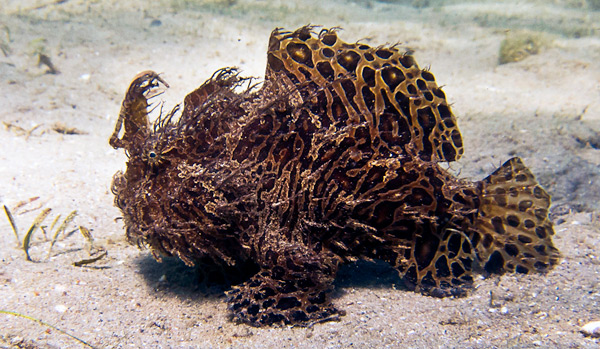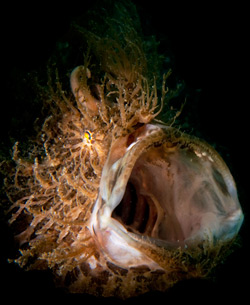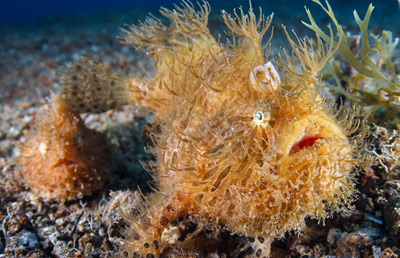Marine aquarists who are drawn to cryptic species with unusual morphology rather than bright colors might want to give the striated frogfish (Antennarius striatus) a second look. Actually, depending on the system it’s kept in, it may be necessary to give it a second (or third or fourth) look, as this angler is truly a master of camouflage.
Physical traits
Like most antennariids, A. striatus is somewhat monstrous—albeit fascinating—in appearance, having a globular body that is cleverly obscured with myriad protrusions and frilly appendages. Its modified pectoral fins look almost like little legs, which is pretty cool (but also kind of creepy). Striated frogfish commonly exhibit brown and tan tiger striping, but they can modify their coloration to blend in with different surroundings. The maximum recorded size for this species is between 8 and 9 inches, though most specimens aren’t apt to get quite that large.

Of course, also being a master angler, A. striatus has a modified dorsal spine, called the illicium, that functions as a fishing rod with a fleshy, wormlike bait, called the esca, at the tip. To attract prey, it flips and wiggles the illicium to make the esca appear lifelike. The prey item, unable to distinguish the fish’s outline, comes in close to snatch what it thinks will be an easy meal but ends up becoming a meal for the frogfish instead.
Feeding
In the wild, A. striatus eats fish and crustaceans, and it’s not unusual for captive specimens to require live offerings, such as ghost shrimp, to initiate feeding. But over time, it should be possible to wean the frogfish off live foods and onto non-living items, such as fish, mollusk, or crustacean meat, presented with tongs or a feeding stick. This species needs to be fed only a few times a week.

Housing
Being a sedentary ambush predator and modest in size, A. striatus is suitable for tanks as small as 30 gallons. Hobbyists have kept them successfully in smaller tanks, but keep in mind that the smaller the system, the greater the strain this species—which does, after all, consume relatively large prey items—will put on water quality. The system’s aquascaping should allow for various perches that the frogfish can choose from for resting/ambush sites. Also, antennariids don’t appreciate ripping water movement, so make sure some of these sites are in areas of relatively slack current.
Compatibility

Combining A. striatus with other fish species can be quite challenging for a couple reasons. One is that it will attempt to eat any fish it can fit in its capacious mouth, possibly including specimens as long as—or even longer than—itself. The other is that all those frilly flaps and appendages can prove irresistible to grazing/nipping fish, which can result in injury to the frogfish. Perhaps the best option is to give A. striatus a tank all its own.
Corals and other sessile invertebrates won’t be intentionally harmed, so A. striatus can be considered reef-safe. However, keep in mind that specimens may come to rest on invertebrates, which can either irritate the invertebrate or, in the case of stinging corals/anemones, harm the frogfish. Ornamental crustaceans will be vulnerable to predation and should be excluded from a tank containing A. striatus.



